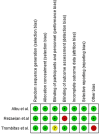The safety and efficacy of spray cryotherapy after endoscopic sinus surgery in chronic rhinosinusitis: A systematic review of randomized controlled trials
- PMID: 39440069
- PMCID: PMC11494270
- DOI: 10.12688/f1000research.143321.2
The safety and efficacy of spray cryotherapy after endoscopic sinus surgery in chronic rhinosinusitis: A systematic review of randomized controlled trials
Abstract
Background: Chronic rhinosinusitis (CRS) is a condition that affects 5-12% of the general population. Endoscopic sinus surgery (ESS) is the preferred treatment because of its few adverse effects and highest success rates. The most common post-operative consequences include synechia, nasal blockage, and disease recurrence. Spray cryotherapy is a novel therapeutic approach with promising outcomes for the treatment of upper airway disorders.This review aimed to investigate the effects of spray cryotherapy (SCT) following ESS in patients with chronic rhinosinusitis.
Methods: Six electronic databases were searched for randomized clinical trials (RCTs). The selected trials were evaluated for methodological quality, and data were extracted by two independent reviewers. The Cochrane risk-of-bias tool was used to assess the quality of evidence.
Results: Three RCTs with 85 patients were included in the final analysis. SCT was related to -16 and -77 reductions in Lund-McKay and SNOT-22 scores after 36 weeks of follow-up, in contrast to a placebo, which showed -10.4, -65. Regarding the side effects of SCT, no adverse effects were reported, and visual assessments showed no pain, visual field loss, or any other ocular complications.
Conclusions: SCT is a new treatment modality after endoscopic sinus surgery that shows an effective post-operative management strategy with better post-operative scales (Lund-McKay, SNOT-22, POSE, and Lund-Kennedy) and less edema, obstruction, crusting, and inflammation with minimal or no side effects. However, further research with longer follow-ups, a larger sample size, and subjective assessment is needed to assess any possible long-term side effects.
Keywords: chronic rhinosinusitis; functional endoscopic sinus surgery; middle meatus antrostomy; nasal polyposis; spray cryotherapy.
Copyright: © 2024 Taha MJJ et al.
Conflict of interest statement
No competing interests were disclosed.
Figures



Similar articles
-
Outcome of Endoscopic Sinus Surgery in the Treatment of Chronic Rhinosinusitis.Mymensingh Med J. 2016 Apr;25(2):261-70. Mymensingh Med J. 2016. PMID: 27277358
-
The influence of spray cryotherapy on wound healing following endoscopic sinus surgery in chronic rhinosinusitis.Laryngoscope. 2016 Jan;126(1):25-32. doi: 10.1002/lary.25257. Epub 2015 Mar 17. Laryngoscope. 2016. PMID: 25780997 Clinical Trial.
-
Efficacy of buffered hypertonic seawater in different phenotypes of chronic rhinosinusitis with nasal polyps after endoscopic sinus surgery: a randomized double-blind study.Am J Otolaryngol. 2020 Sep-Oct;41(5):102554. doi: 10.1016/j.amjoto.2020.102554. Epub 2020 May 26. Am J Otolaryngol. 2020. PMID: 32521299 Clinical Trial.
-
Sinonasal debridement versus no debridement for the postoperative care of patients undergoing endoscopic sinus surgery.Cochrane Database Syst Rev. 2018 Nov 8;11(11):CD011988. doi: 10.1002/14651858.CD011988.pub2. Cochrane Database Syst Rev. 2018. PMID: 30407624 Free PMC article.
-
Postoperative Oral Corticosteroid Use Following Endoscopic Sinus Surgery for Chronic Rhinosinusitis: A Systematic Review and Meta-Analysis.Am J Rhinol Allergy. 2025 Jul;39(4):322-332. doi: 10.1177/19458924251335075. Epub 2025 Apr 24. Am J Rhinol Allergy. 2025. PMID: 40270102
References
Publication types
MeSH terms
Associated data
LinkOut - more resources
Full Text Sources
Medical

